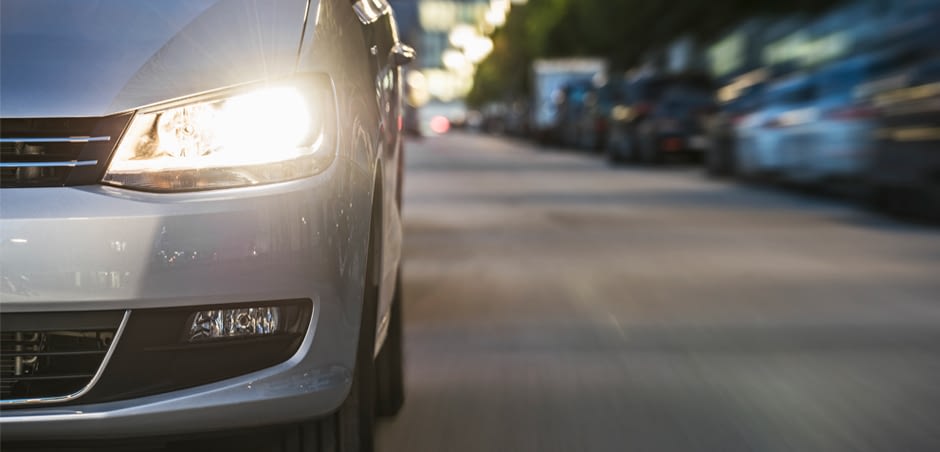
How often do you think about your headlights while you are driving?
For most drivers, headlights are not typically top-of-mind, but according to the Insurance Institute for Highway Safety (IIHS), high-quality headlights are crucial for avoiding hazards on the road. This underscores the important relationship between nighttime visibility and safe driving. And one of the best ways to improve visibility is through proper use of your vehicle’s headlights.
Headlights often go unnoticed until a bulb has burned out. But paying a little extra attention to your car’s lights could help improve visibility on your next nighttime drive. It could also mean the difference between arriving safely at your destination and being involved in a costly accident.
When Should I Use My Headlights?
This statement is obvious, but it’s still worth noting: your headlights can only help you improve visibility when they’re turned on.
Remembering to turn on your headlights isn’t usually an issue after dark. But it can easily slip your mind at dawn and dusk, when visibility is decreased but it’s not quite fully dark. All states require that your car’s headlights are used between sunset and sunrise. But it’s also wise to turn them on during twilight hours.
Headlight use is also mandated during low-visibility conditions. To help in those situations, read our related posts:
- How to Drive in Heavy Rain
- 6 Common Mistakes of Winter Drivers
- 5 Tips for Driving in Fog
- Trouble Driving at Night? Read These 6 Tips
What Are Daytime Running Lights?
To ensure you’re always driving with enough light, modern cars have started implementing automatic headlights and daytime running lights. Automatic headlights will turn on when a sensor detects that it’s getting dark outside. Daytime running lights, on the other hand, stay on whenever your car is running. These low-intensity lights are an added safety feature and have been proven to reduce daytime collisions, according to the IIHS.
When Should I Use My High Beams?
Your vehicle’s high-beam headlights (also known as “brights”) are a great tool to use in low-visibility situations. However, the added light they emit can also be blinding to oncoming traffic.
Here’s what to know:
- Low beams vs. high beams: Low-beam headlights provide a down-the-road view of about 200-300 feet, depending on your vehicle. And using your high-beam headlights can extend that visibility to upward of 500 feet. For that reason, high beams are great to use on low-traffic rural roads or when traveling on a dark highway at high speeds.
- When to dim the brights: But when you approach oncoming traffic, you’ll need to dim the brights. Not only is it the law in most states, but you’ll also compromise the visibility of other drivers if you don’t, which can create a dangerous situation.
- When not to use your high beams: It’s also important to remember that your high beams aren’t helpful in rain, fog or snow. That’s because the bright light will reflect off of the water droplets, reducing your visibility. In inclement weather, it’s best to use fog lights instead, if your vehicle has them.
What Types of Headlights Are Available?
When it comes to the task of illuminating the road ahead, not all headlights are created equal. Today, most headlights fall into one of the following categories:
- Halogen: Halogen lights are the most common type of headlight bulb. They work similarly to the light bulbs in your house. Light travels through a thin wire filament and the bulb is filled with halogen gas to make it burn brightly. When buying replacement halogen bulbs, you’ll find a variety of options. More expensive bulbs will shine brighter while emitting a whiter colored light, which helps to improve visibility.
- HID/Xenon: HID stands for “high-intensity discharge.” This type of light works differently than halogen bulbs. Instead of using a filament, they produce an arc of electricity that jumps across two electrodes. And instead of using halogen gas, the bulb is filled with xenon gas. HID lights require special equipment to operate. For that reason, they can’t be easily retrofitted to a car that was originally equipped with halogen bulbs. The light they produce is brighter and whiter, and while the bulbs do generally last longer, they’re also more expensive to replace.
- LED: LED stands for “light-emitting diode.” These types of headlights are becoming more common on new vehicles because of their high light output, low energy usage and long life span.
How Do I Replace a Headlight Bulb?
- Find the right size: When replacing a headlight bulb, the first step is to find the correct bulb size for your vehicle. You can do this by searching online or by visiting your local auto parts store.
- Go for two: Headlight bulbs are commonly sold in pairs, and it’s recommended that you change both at the same time because if one bulb fails, the other won’t be far behind.
- Check the manual: The replacement procedure will be different for every vehicle, so check your owner’s manual if you’re unsure of how to change the headlight bulb.
- Get started: Generally, you’ll start by unclipping the wiring harness that attaches to the bulb. Then, rotate the bulb (usually counterclockwise) and remove it from the housing.
- Avoid touching the glass: When inserting your replacement bulb, be sure to wear gloves and avoid touching the glass of the light bulb as the oils from your hand can cause premature failure.
- Twist into place: To complete the job, twist the bulb into place, hook up the wiring harness and test out your new headlights.
Why Do Headlights Get Cloudy Over Time?
If you’re having trouble seeing at night, the problem may not be the headlight bulbs. Instead, it may be your vehicle’s headlight housing.
Your car’s headlights are made from a polycarbonate plastic. Unlike the glass used in older vehicles, this material is tough enough to withstand impact from rocks and debris without cracking. But over time, UV light can lead to oxidation of the plastic. The result is that your car’s headlights may appear hazy, cloudy or yellowed. Luckily, headlight oxidation can be quickly and easily repaired from the comfort of your own driveway.
How Do I Restore a Cloudy Headlight?
To repair an oxidized headlight, you’ll need to remove a thin layer of plastic from your vehicle’s headlight housing. To get started, follow these simple steps:
- Buy the materials. To restore your headlights, you’ll need some high-grit sandpaper, polishing compound, UV sealant, painter’s tape and a microfiber towel. You can buy these materials separately, but it’s easiest to buy a headlight restoration kit at your local auto parts store.
- Prepare your vehicle. Before you start sanding, wash and dry your headlights. Then, use painter’s tape to mask off the area around your headlights. This will prevent potential damage to any painted surfaces.
- Start sanding. Now, it’s time to start wet sanding the headlight to remove the oxidization. Every kit is different, so be sure to follow the manufacturer’s instructions.
- Polish and buff. To see the results of your sanding, use the provided polishing compound and a microfiber towel to buff out your headlight using small, circular motions.
- Apply sealant. To keep your headlights from getting cloudy again, apply UV sealant to the fresh plastic surface. Then, enjoy your clear view.
What Headlight Technologies Are Available When Buying a New Car?
As new car technologies evolve, you’ll find that more and more headlight options are available. If you’re shopping for a new vehicle, consider checking out these advanced safety options:
- Adaptive headlights: Limited visibility can make driving at night difficult, especially on curvy roads. Adaptive headlights aim to improve nighttime vision by adjusting the headlight direction to the road ahead. While standard headlights always point in one direction, cars with adaptive headlights use sensors to measure a driver’s steering inputs and turn the angle of the headlights to provide a better view. So, when you’re taking a turn, you’ll be more likely to see where you’re headed instead of illuminating the side of the road.
- High-beam assist: As we’ve already mentioned, high-beam headlights can add hundreds of feet to your nighttime visibility. However, they require work from the driver to turn them on and off at the appropriate times. High-beam assist technology does the work for you by using sensors to decide when high beams should be activated. This lets you effortlessly use your high beams as much as possible without the risk of blinding oncoming traffic.
Read our related post on why it’s helpful to talk to a local insurance agent before you buy a car.
If you’re in the market for a new car, you may also want to check out headlight ratings from the IIHS. By performing a variety of tests and assigning grades of good, acceptable, marginal or poor, these rankings let you know how a car’s headlights stack up against the competition.
Keeping You Focused on the Road Ahead
At Erie Insurance, our promise is simple: to be there when you need us. We make it our mission to provide the protection and service you deserve so you can focus on the road ahead. To learn how to get the best protection for you and your vehicle,talk to your local ERIE agent for a free, no-obligation auto insurance quote.

A better insurance experience starts with ERIE.
Haven’t heard of us? Erie Insurance started with humble beginnings in 1925 with a mission to emphasize customer service above all else. Though we’ve grown to reach the Fortune 500 list, we still haven’t lost the human touch.
Contact Merlo Insurance today to experience the ERIE difference for yourself.
